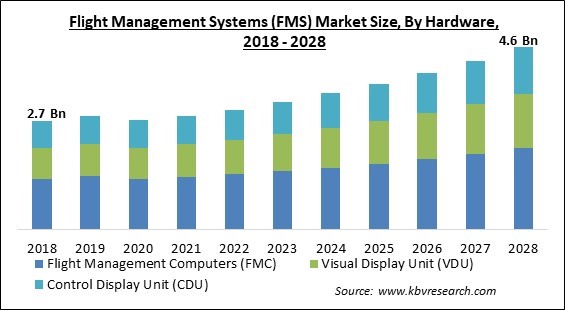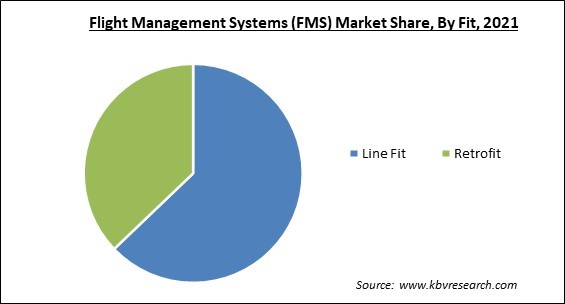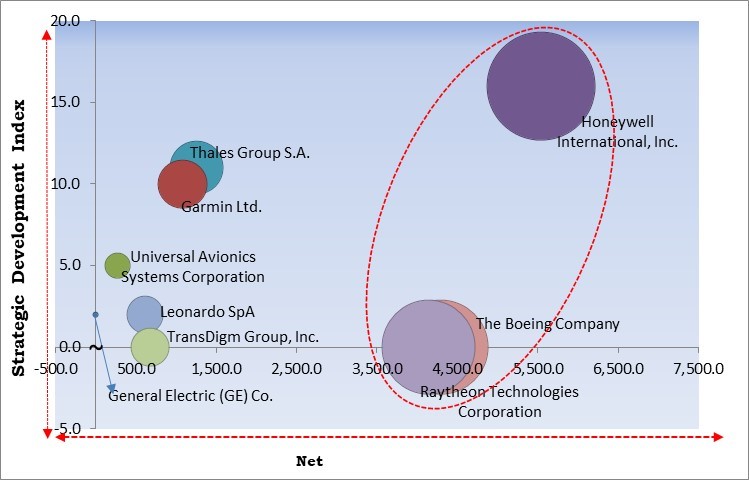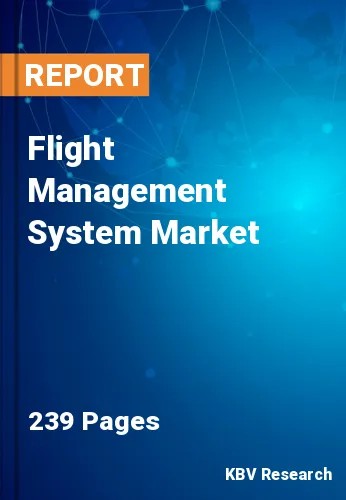The Global Flight Management System Market size is expected to reach $4.6 billion by 2028, rising at a market growth of 7.2% CAGR during the forecast period.
A flight management system, or FMS, is an on-board multi-purpose performance, navigation, and aircraft operations computer, which is designed to deliver virtual data along with operational harmony between open and closed elements associated with a flight from pre-engine outset and takeoff to landing and engine shut-down. Flight management systems, which take the place of traditional technologies and flight deck displays, are present in the majority of contemporary commercial and business aircraft.

An FMS is made up of four basic parts viz. a Flight Management Computer (FMC), an Electronic flight instrument system (EFIS), an Automatic Flight Control, and an Aircraft Navigation System. One of the most important avionics systems of a contemporary airplane is the flight management system. A sophisticated computer system called an FMS automates a wide range of in-flight activities, lightening the strain on the flight crew in order to the point where flight engineers and navigators are no longer carried on modern commercial aircraft.
The administration of the flight plan while in flight is a key duty. The FMS can direct the aircraft all along the flight plan by using a variety of sensors, such as GPS and INS, which are frequently supported by radio navigation to detect the position of the aircraft. The FMS is often operated from the cockpit via a Control Display Unit (CDU), which includes a tiny screen, keyboard, and touchscreen.
The COVID-19 pandemic led various economies all over the world and affected a number of businesses of all sizes. Governments all over the world were compelled to enforce lockdowns within their countries to regulate the spread of the infection. In addition, various manufacturing units of several goods were temporarily closed due to lockdowns. The manufacturing of hardware parts of flight management systems was also hampered. The flight management systems market has also experienced unexpected changes as a result of COVID-19's abrupt outbreak. Most significantly, the travel restrictions across the world majorly hauled aviation operations, which delivered very severe harm to the flight management system market.
A retrofit of the Flight Management System (FMS) improves operational flexibility and reliability, boosts dispatch and on-time arrival availability, simplifies maintenance, and enhances safety by reducing crew workload and improving situational awareness. The FMS has full performance mission planning and navigation capabilities, storage for up to 100 Flight Plans, storage for up to 128 Waypoints, the option to maintain a Global Navigation Database on a 32 GB Solid State Drive, a standard ARINC 424 Database, and interaction with current IRU/AHRS hardware.
The aviation industry is rapidly growing, and the air transport sector is growing. Additionally, according to the International Civil Aviation Organization, around 4.1 billion passengers flew on airplanes around the world in 2017. 37 million commercial flights carried 56 million tons in freight. Over 10 million people and about 18 billion dollars worth of cargo are transported daily by airplanes. This demonstrates the huge economic influence that aviation has had on the world economy, which is further supported by the fact that aviation accounts for 3.5% of the global GDP (2.7 trillion US dollars) and has generated 65 million employments worldwide.
Aerodrome construction and maintenance are highly expensive. It also necessitates the hiring of professional, skilled, and qualified workers. The most expensive mode of transportation is often thought to be air travel. Aerodrome and aviation construction expenditures as well as the cost of maintaining aircraft are substantially greater. Because of this, air travel has become unaffordable for most people. The lack of space in the aircraft makes them unsuitable for transporting heavy and less expensive commodities.

By Hardware, the Flight Management System Market is segmented into Visual Display Unit (VDU), Control Display Unit (CDU), and Flight Management Computers (FMC). In 2021, the flight management computer segment witnessed the biggest revenue share of the flight management system market. The high growth of the segment is due to the fact that this is a very essential component of any FMS. FMC is a computer that serves as the brains of a flight management system and provides a centralized command over navigation and performance monitoring. It significantly aids the pilot in preventing several accidents and hence, the growth of the segment is boosted.
Based on Fit, the Flight Management System Market is bifurcated into Line Fit and Retrofit. In 2021, the retrofit segment garnered a significant revenue share of the flight management system market. One of the most in-demand services in the aerospace sector is the retrofit and systems upgrade activity. This is due to the aging of aircraft, changing air transport operations, and parts obsolescence. The airframers' decision to make the improvements or an airworthiness regulation addressing operational changes, such as those required in the NextGen and Sesar programs, is what primarily drives the retrofit campaigns.
On the basis of Aircraft Type, the Flight Management System Market is segregated into Narrow Body Aircraft, Wide Body Aircraft, Very Large Aircraft, and Regional Transport Aircraft. In 2021, the narrow body aircraft segment procured the highest revenue share of the flight management system market. The increasing growth of this segment is primarily attributed to an increase in the demand for narrow-body aircraft owing to their high flexibility during operation. A narrow-body aircraft, commonly referred as a single-aisle aircraft, is a smaller model that is frequently employed to conduct short-haul domestic and international flights.
| Report Attribute | Details |
|---|---|
| Market size value in 2021 | USD 2.9 Billion |
| Market size forecast in 2028 | USD 4.6 Billion |
| Base Year | 2021 |
| Historical Period | 2018 to 2020 |
| Forecast Period | 2022 to 2028 |
| Revenue Growth Rate | CAGR of 7.2% from 2022 to 2028 |
| Number of Pages | 239 |
| Number of Tables | 353 |
| Report coverage | Market Trends, Revenue Estimation and Forecast, Segmentation Analysis, Regional and Country Breakdown, Competitive Landscape, Companies Strategic Developments, Company Profiling |
| Segments covered | Hardware, Fit, Aircraft Type, Region |
| Country scope | US, Canada, Mexico, Germany, UK, France, Russia, Spain, Italy, China, Japan, India, South Korea, Singapore, Malaysia, Brazil, Argentina, UAE, Saudi Arabia, South Africa, Nigeria |
| Growth Drivers |
|
| Restraints |
|
Region-wise, the Flight Management System Market is analyzed across North America, Europe, Asia-Pacific, and LAMEA. In 2021, North America accounted for the largest revenue share of the flight management system market. The rapid rise in the growth of the segment is owing to the wide presence of a number of market players operating in this region. In addition, North America also comprises a very robust aviation industry, which is also contributing to the adoption of flight management systems across the region. These factors are expediting the growth of the regional market.
Free Valuable Insights: Global Flight Management System Market size to reach USD 4.6 Billion by 2028

The major strategies followed by the market participants are Partnerships. Based on the Analysis presented in the Cardinal matrix; Honeywell International, Inc., Raytheon Technologies Corporation and The Boeing Company are the forerunners in the Flight Management System Market. Companies such as Universal Avionics Systems Corporation, Leonardo SpA and Thales Group S.A. are some of the key innovators in Flight Management System Market.
The market research report covers the analysis of key stake holders of the market. Key companies profiled in the report include Honeywell International, Inc., General Electric (GE) Co., Thales Group S.A., Garmin Ltd., Universal Avionics Systems Corporation, Leonardo SpA, Lufthansa Systems GmbH & Co. KG, TransDigm Group, Inc., Raytheon Technologies Corporation and The Boeing Company.
By Hardware
By Fit
By Aircraft Type
By Geography
The global Flight Management System Market size is expected to reach $4.6 billion by 2028.
Higher operational efficiency along with increased flexibility are driving the market in coming years, however, High cost of air travel as well as flight management system restraints the growth of the market.
Honeywell International, Inc., General Electric (GE) Co., Thales Group S.A., Garmin Ltd., Universal Avionics Systems Corporation, Leonardo SpA, Lufthansa Systems GmbH & Co. KG, TransDigm Group, Inc., Raytheon Technologies Corporation and The Boeing Company.
The expected CAGR of the Flight Management System Market is 7.2% from 2022 to 2028.
The Line Fit market is leading the Global Flight Management Systems (FMS) Market by Fit in 2021; thereby, achieving a market value of $2.8 billion by 2028.
The North America market is showing high growth in the Global Flight Management Systems (FMS) Market by Region in 2021; thereby, achieving a market value of $1.6 billion by 2028.
Our team of dedicated experts can provide you with attractive expansion opportunities for your business.

